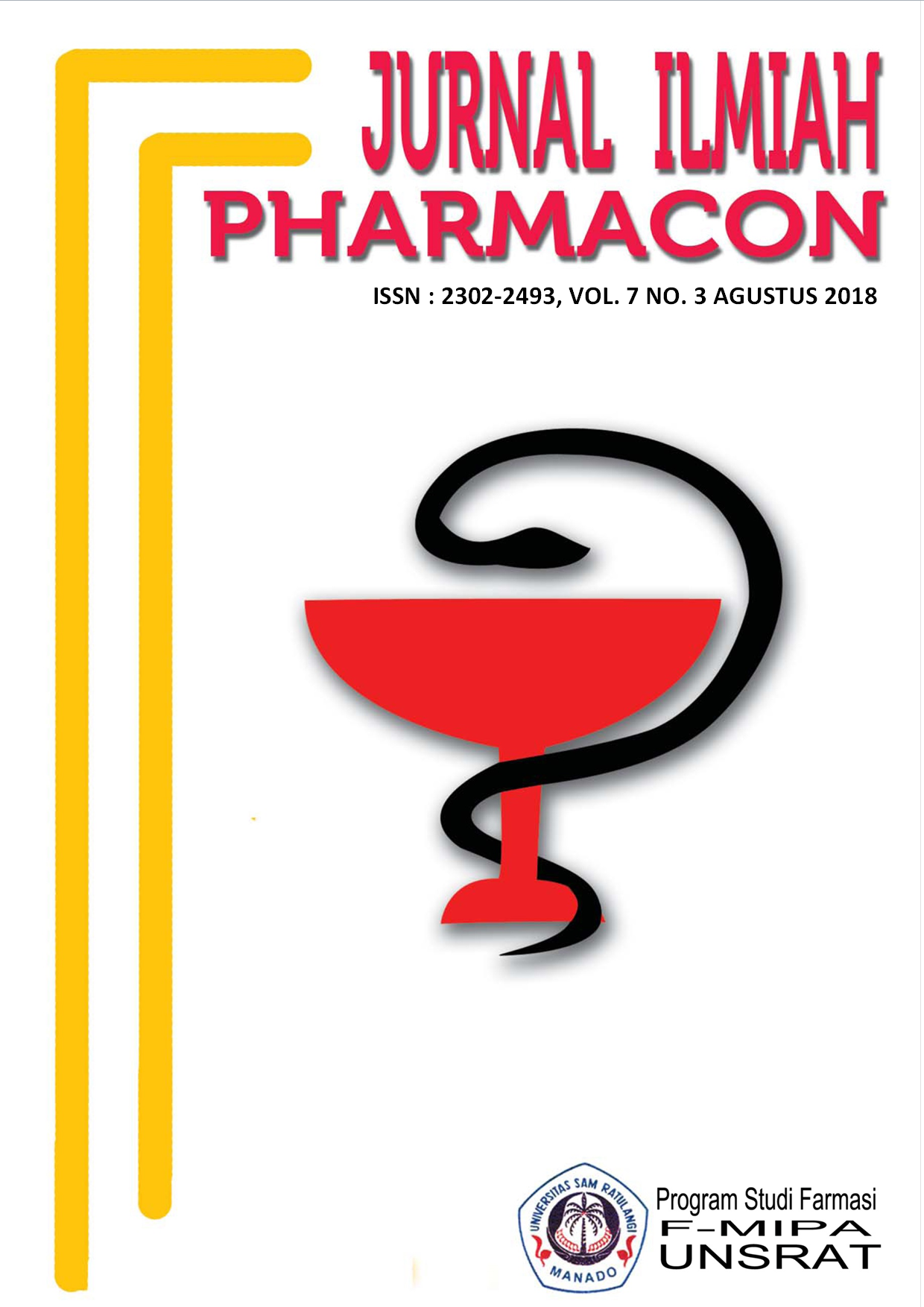UJI AKTIVITAS ANTIMIKROBA JAMUR LAUT YANG BERASOSIASI DENGAN SPONS Phyllospongia lamellose
DOI:
https://doi.org/10.35799/pha.7.2018.20503Abstract
UJI AKTIVITAS ANTIMIKROBA JAMUR LAUT YANG BERASOSIASI DENGAN SPONS Phyllospongia lamellose
Giovanny E. Payangan1), Fatimawali1), Henki Rotinsulu1)
1)PS Famasi FMIPA Universitas Sam Ratulangi, Manado, 95115
ABSTRACT
Sponges are marine organisms that inhabited coral reefs. These marine animals are known to containe compounds which has the potential to be developed in the field of medicine as antimicrobials. This study aims to determine whether the marine fungi associated with Phyllospongia lamellose Sponge has antimicrobial activity. The study included sponge sampling of Phyllospongia lamellose, isolation and inoculation of fungi associated with sponges, fermentation, extraction with acetone continued with fractionation with ethyl acetate solvent, and antimicrobial testing aginst Staphylococcus aureus, Echerichia coli, and Candida albicans. Test activity was performed by agar diffusion method, the antimicrobial activity was measured from the inhibitory zone formed around the paper disc to the test microbe. The results showed that the fungi associated with Phyllospongia lamellose sponge had a 7 mm inhibitory zone to Staphylococcus aureus, 6 mm to Echerichia coli, 13.3 mm to Candida albicans. It can be concluded that the fungi associated with Phyllospongia lamellose sponge have moderate antimicrobial activity against Staphylococcus aureus, Echerichia coli, and strong Candida albicans.
Keywords : Phyllospongia lamellose sponge, antimicrobial, Staphylococcus aureus, Echerichia coli, Candida albicans.
ABSTRAK
Spons merupakan salah satu biota laut penyusun terumbu karang. Hewan laut ini diketahui mengandung senyawa-senyawa yang berpotensi untuk dikembangkan dalam bidang pengobatan diantaranya sebagi antimikroba. Penelitian ini bertujuan untuk mengetahui apakah jamur yang berasosiasi dengan spons Phyllospongia lamellose memiliki aktivitas antimikroba. Penelitian dilakukan meliputi sampling spons Phyllospongia lamellose, isolasi dan inokulasi jamur yang berasosiasi dengan spons, fermentasi, ektraksi dengan aseton kemudian difraksinasi dengan pelarut etil asetat, dikeringkan hingga mendapat ekstrak kasar dan pengujian antimikroba pada bakteri Staphylococcus aureus, Ercherchia coli, dan jamur Candida albicans. Uji aktivitas antimikroba dilakukan dengan metode difusi agar. Aktivitas antimikroba didapatkan dari zona hambat yang terbentuk disekitaran cakram kertas terhadap mikroba uji. Dari hasil penelitian didapatan bahwa jamur yang berasosiasi dengan spons Phyllospongia lamellose memiliki daya zona hambat 7 mm terhadap Stapylococcus aureus, 6 mm terhadap Ercherchia coli, 13,3 mm terhadap Candida albicans. Dapat disimpulkan bahwa jamur yang berasosiasi dengan spons Phyllospongia lamellose memiliki aktivitas antimikroba sedang terhadap Stapylococcus aureu, Ercherchia coli, dan kuat terhadap Candida albicans.
Kata Kunci : Spons Phyllospongia lamellose, Antimikroba, Stapylococcus aureu, Ercherchia coli, Candida albicans.
Â
Downloads
Published
How to Cite
Issue
Section
License
Authors who publish with this journal agree to the following terms:
- Authors retain copyright and grant the journal right of first publication with the work simultaneously licensed under a Creative Commons Attribution License that allows others to share the work with an acknowledgement of the work's authorship and initial publication in this journal.
- Authors are able to enter into separate, additional contractual arrangements for the non-exclusive distribution of the journal's published version of the work (e.g., post it to an institutional repository or publish it in a book), with an acknowledgement of its initial publication in this journal.
- Authors are permitted and encouraged to post their work online (e.g., in institutional repositories or on their website) prior to and during the submission process, as it can lead to productive exchanges, as well as earlier and greater citation of published work (See The Effect of Open Access)










